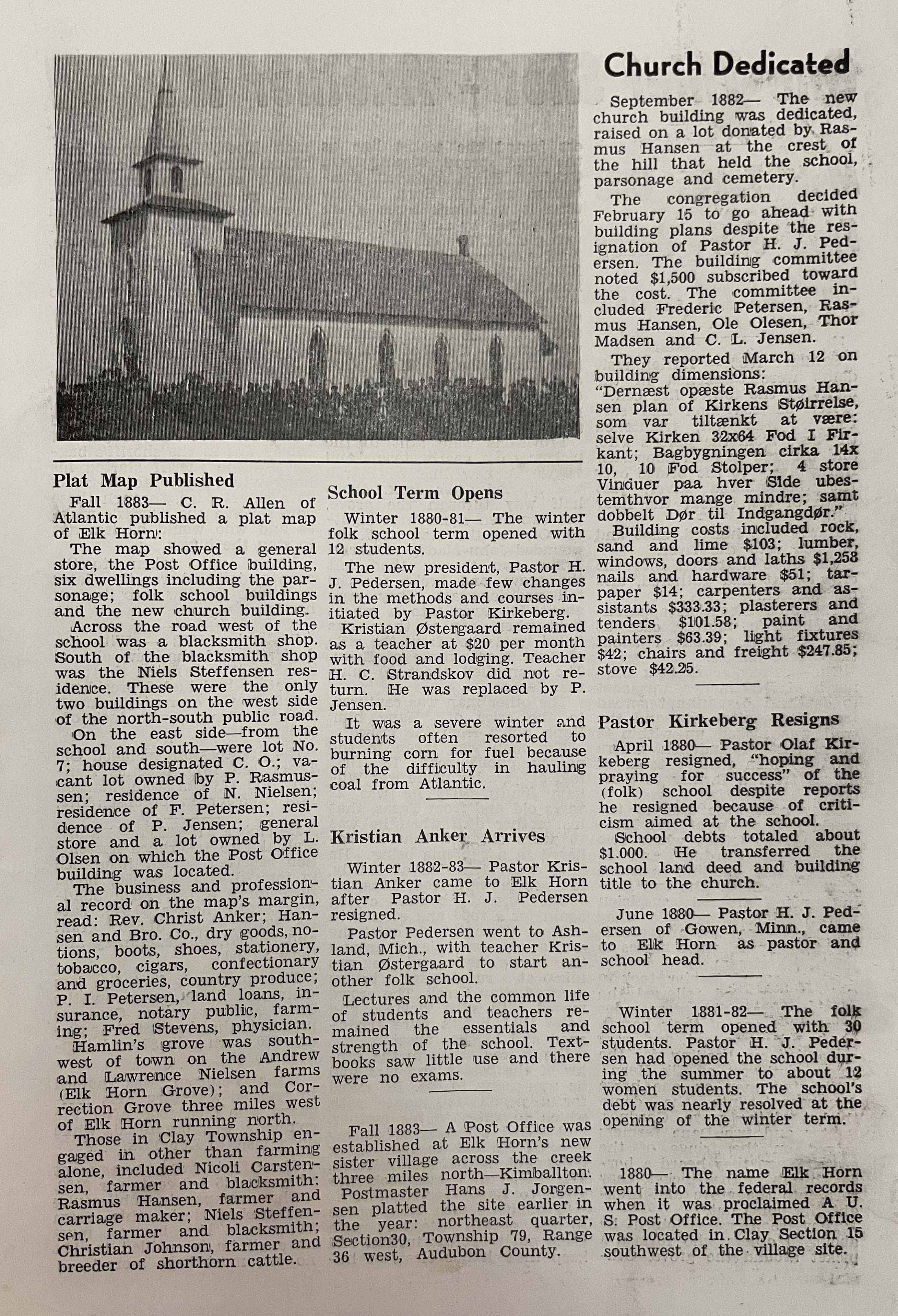Plat Map Published
Fall 1883--C. R. Allen of Atlantic published a plat map of Elk Horn:
The map showed a general store, the Post Office building, six dwellings including the parsonage; folk school buildings and the new church childing.
Across the road west of the school was a blacksmith shop. South of the blacksmith shop was the Niels Steffensen residence. These were the only two buildings on the west side of the north-south public road.
On the east side--from the school and south--were lot No. 7; house designated C. O.; vacant lot owned by P. Rasmussen; residence of N. Nielsen; residence of F. Petersen; residence of P. Jensen; general store and a lot owned by L. Olsen on which the Post Office building was located.
The business and professional record on the map's margin read: Rev. Christ Anker; Hansen and Bros. Co., dry goods, notions, boots, shoes, stationery, tobacco, cigars, confectionary and groceries, country produce; P. I. Petersen, land loans, insurance, notary public, farming; Fred Stevens, physician.
Hamlin's grove was southwest of town on the Andrew and Lawrence Nielsen farms (Elk Horn Grove); and Correction Grove three miles west of Elk Horn running north.
Those in Clay Township engaged in other than farming alone, included Nicoli Carstensen, farmer and blacksmith; Rasmus Hansen, farmer and carriage maker; Niels Steffensen, farmer and blacksmith; Christian Johnson, farmer and breeder of shorthorn cattle.
School Term Opens
Winter 1880-81--The winter folk school term opened with 12 students.
The new president, Pastor H. J. Pedersen, made few changes in the methods and courses initiated by Pastor Kirkeberg.
Kristian Ostergaard remained as a teacher at $20 per month with food and lodging. Teacher H. C. Strandskov did not return. He was replaced by P. Jensen.
It was a severe winter and students often resorted to burning corn for fuel because of the difficulty in hauling coal from Atlantic.
Kristian Anker Arrives
Winter 1882-83--Pastor Kristian Anker came to Elk Horn after Pastor H. J. Pedersen resigned.
Pastor Pedersen went to Ashland, Mich., with teacher Kristian Ostergaard to start another folk school.
Lectures and the common life of students and teachers remained the essentials and strength of the school. Textbooks saw little use and there were no exams.
Fall 1883--A Post Office was established at Elk Horn's new sister village across the creek three miles north--Kimballton.
Postmaster Hans J. Jorgensen platted the site earlier in the year: northeast quarter, Section 30, Township 79, Range 36 west, Audubon County.
Church Dedicated
September 1882--The new church building was dedicated, raised on a lot donated by Rasmus Hansen at the crest of the hill that held the school, parsonage and cemetery.
The congregation decided February 15 to go ahead with building plans despite the resignation of Pastor H. J. Pedersen. The building committee noted $1,500 subscribed toward the cost. The committee included Frederic Petersen, Rasmus Hansen, Ole Olesen, Thor Madsen and C. L. Jensen.
They reported March 12 on building dimensions:
"Dernaest opaeste Rasmus Hansen plan of Kirkens Størrelse, som var tiltaenkt at vaere; selve Kirken 32x64 Fod I Firkant; Bagbygningen cirka 14x10, 10 Fold Stolper; 4 store Vinduer paa hver Side ubestemthvor mange mindre; samt dobbelt Dør til Indgangdør."
[Translated from Danish: Then Rasmus Hansen came up with a plan for the size of the church, which was intended to be; the Church itself 32x64 Feet In Square; The rear building approximately 14x10, 10 Fold Posts; 4 large windows on each side indeterminate many smaller; as well as double Door to Entrance Door.]
Building costs included rock, sand and lime $103; lumber, windows, doors and laths $1,258; nails and hardware $51; tarpaper $14; carpenters and assistants $333.33; plasterers and tenders $101.58; paint and painters $63.39; light fixtures $42; chairs and freight $247.85; stove $42.25.
Pastor Kirkeberg Resigns
April 1880--Pastor Olaf Kirkeberg resigned, "hoping and praying for success" of the (folk) school despite reports he resigned because of criticism aimed at the school.
School debts totaled about $1,000. He transferred the school land deed and building title to the church.
June 1880--Pastor H. J. Pedersen of Gowen, Minn., came to Elk Horn as pastor and school head.
Winter 1881-82--The folk school term opened with 30 students. Pastor H. J. Pedersen had opened the school during the summer to about 12 women students. The school's debt was nearly resolved at the opening of the winter term.
1880--The name Elk Horn went into the federal records when it was proclaimed A U. S. Post Office. The Post office was located in Clay Section 15 southwest of the village site.
 Previous
Previous < == > Next
Transcribed by Cheryl Siebrass from Elk Horn 1868-1918, July, 2022, page 7.
|